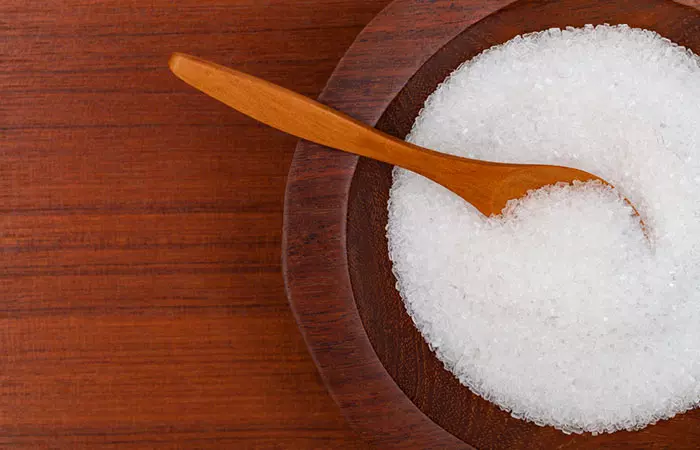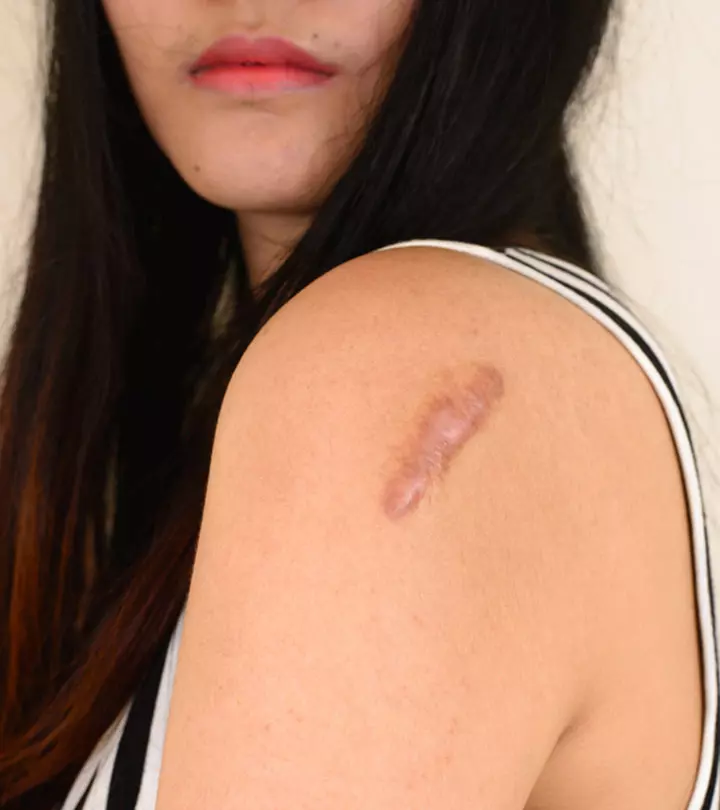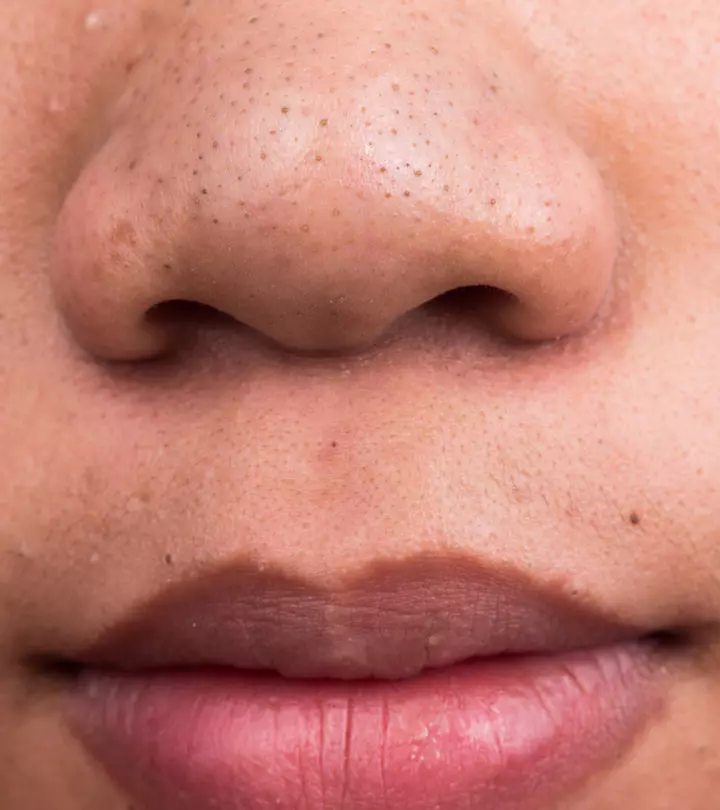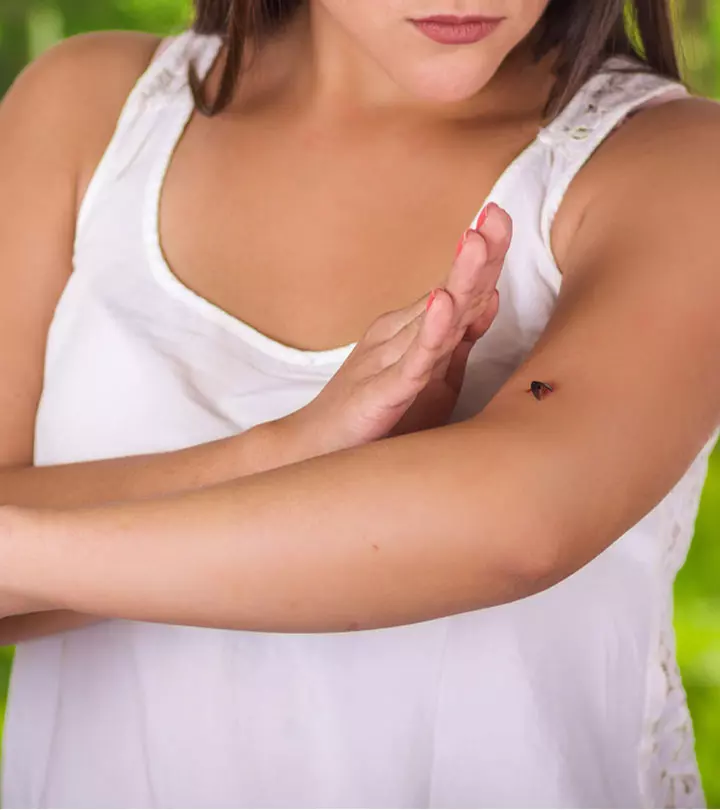Frostbite: Causes, Symptoms, Stages, Treatment, & Prevention
Take necessary precautions before it is too late by knowing the condition's symptoms.

Image: Shutterstock
Long exposure to extreme cold temperatures in the winter can results in a person developing frostbite. Commonly seen in your fingers, nose, ears, and toes, frostbite can spread throughout the entire body. While in most cases, superficial frostbite goes away on its own, if left untreated for a long time, it can lead to serious health complications. In this article, we look at some of the natural remedies and tips you can try at home to treat frostbite at home.
 Fun Fact
Fun FactIn This Article
What Is Frostbite?
Exposing your body to temperatures below the freezing point of your skin can freeze your tissues, causing frostbite. Anyone is susceptible to this condition, including those living in cold climates. Your extremities like your ears, nose, hands, toes, and feet are the most vulnerable to frostbite.
Frostbites can either be superficial or deep. Superficial frostbites occur on the surface and are comparatively less severe than deep frostbites.
A frostbite injury can be serious if not treated on time. According to the National Inpatient Sample (2016-2018), the overall incidence of frostbite injury in the United States is 0.83 for every 100,000 people. The data also indicates that disability from amputation due to frostbite injury affects at least 20% of frostbite-injured patients.
Key Takeaways
- A deep frostbite may turn the skin black and is caused by several reasons such as the constriction of blood vessels.
- Treat the affected area by immersing it in warm water.
- Apply a few drops of vitamin E oil to soften your skin and heal frostbite.
- Use oils such as cypress oil to relieve the redness.
- Use mittens, dress up in warm clothing, and limit your presence outside during cold weather to reduce the risk of frostbite.
Stages Of Frostbites
There are several stages of frostbite.
- Frostnipi A mild frostbite that is characterized by a change of color and a cold sensation followed by numbness in parts of the body.
This is the first stage of frostbite, where your skin turns pale or red and very cold. Prolonged exposure to low temperatures can cause pain and a tingling sensation with no permanent damage.
- Superficial Frostbite
You know your frostbite is proceeding to the second stage if it first appears as reddened skin that turns pale or white. Although your skin may remain soft, you will start noticing the formation of ice crystals in your tissues.
- Severe (Deep) Frostbite
As the frostbite progresses, it affects all your skin layers, including the deep tissues. You will experience pain, numbness, and sensations of cold.
The following are some of the common signs and symptoms associated with the superficial and deep frostbite.
Signs And Symptoms Of Frostbite
If you are suffering from superficial frostbite, you may experience:
- Numbness
- Chilblains or itchy skin sores on the skin
- Tingling
- Itching
- Cold sensations in the affected area
Similarly, if you have ice burns, a condition caused by direct contact with ice, you may experience similar symptoms to frostbite, including pain, swelling, and discoloration of the skin.
Greg Benedis-Grab, a blogger, wrote about how he developed frostbite due to a bad mountain hiking experience. He said, “As my shoes thawed out I experienced unusual sensations with each stepMy pinky toes were a bluish color, irritated, and quite numb. I clearly had the early stages of frostbite (i).”
Also, your skin may appear white or frozen.
Deep frostbite, on the other end, may result in:
- An initial decrease in sensation that may be completely lost over time
- Swelling
- Blood-filled blistering
- Skin turning yellow or white with a waxy appearance
- Significant pain when the area is rewarmed
- Skin looking dead or turning black
If you develop blood blisters due to frostbite or other injuries, there are home remedies to get rid of blood blisters that can help reduce discomfort. Still, it is essential to seek medical attention for proper treatment.
Naveen Mallesh, a mountaineer and lifestyle blogger, wrote about experiencing frostbite during his Mt. Manaslu climb. He said, “While getting ready I just removed my socks and had a look at my feet and saw a light blackish tone and this was the first sign of frostbite (ii).”
When exposed to an extremely cold climate, your body undergoes changes to keep you alive. Frostbite is a result of such changes.
Causes And Risk Factors For Frostbites
The most common causes of frostbite are:
- Constrictioni A feeling of tightness caused by the narrowing of blood vessels due to psychological, medical and environmental conditions. of blood vessels (your body signals blood flow to vital organs)
- As the temperature drops, your blood vessels get dilated for a short period before constricting again. But when your body temperature drops below 98.6°F, your blood vessels constrict permanently to prevent cold blood from returning to your internal organs. Such a scenario indicates the beginning of frostbite.
Frostbite is caused in two ways:
- Cell death at the time of exposure to cold
- Further cell death and deterioration due to lack of oxygen
Some factors that may increase frostbite risk include:
- Medical conditions like dehydration, diabetes, exhaustion, and Reynaud’s phenomenon poor blood flow that impair your response to low temperatures
- Alcohol/drug abuse
- Smoking
- Stress, anxiety, depression, or other mental illnesses
- A history of frostbite or cold injury
- Age – older adults and infants are at a higher risk of developing frostbite.
- Being at a high altitude, which reduces the oxygen supply to your skin.
According to an analysis published in CMAJ Open about the 22 frostbite cases reported at Whitehorse General Hospital, Whitehorse, Yukon Territory, Canada, between Feb. 9, 2015, and Feb. 8, 2020, it was found that 86% of the cases occurred at a temperature of −21°C or colder. Most cases occurred between −21°C and −30°C. Also, there was no significant correlation between the duration of cold exposure and frostbite severity. Check out the graph below to understand the analysis in detail.

Frostbite Severity By Local Environmental Temperature
Source: Management of severe frostbite with iloprost, alteplase and heparin: a Yukon case seriesLet’s now understand how you can diagnose frostbite.
How Are Frostbites Diagnosed?
Frostbites are diagnosed based on your physical signs and symptoms. A doctor analyzes your skin appearance and reviews your recent activities (where you might have gotten exposed to cold).
Your physician may also conduct tests like an X-ray, bone scan, or magnetic resonance imaging (MRI)i A medical imaging technology that is used to create detailed 3D images of internal organs and tissues inside the body. to determine whether the frostbite has caused damage to your bone or muscles.
Since frostbite can occur to anyone, knowing simple frostbite treatments at home can really help. Scroll down to know more.
How To Treat Frostbite Naturally
5 Natural Treatments For Frostbite
1. Warm Water
You Will Need
A bucket of warm (not hot) water
What You Have To Do
Soak your frostbitten hands/feet in warm water until your symptoms disappear.
How Often You Should Do This
Do this as and when required.
Why This Works
Soaking the frostbitten body part in warm water for a few minutes helps in re-initiating blood flow to it
. This works as an immediate remedy that can prevent worsening of a frostbite (1).
2. Essential Oils
a. Helichrysum Oil

You Will Need
- 3-4 drops of helichrysum oili An essential oil made from fresh helichrysum flowers that has healing and restorative properties.
- 1 teaspoon of coconut oil (or any other carrier oil)
What You Have To Do
- Mix three drops of helichrysum oil with a teaspoon of coconut oil.
- Apply the mixture to the affected areas and leave it on.
How Often You Should Do This
You must do this 1 to 2 times daily.
Why This Works
The anti-inflammatory properties of helichrysum oil can heal the blisters from frostbites. The oil also relieves pain and redness (2).
b. Cypress Oil

You Will Need
- 3-4 drops of cypress oil
- 1 teaspoon of coconut oil (or any other carrier oil)
What You Have To Do
- Mix three drops of cypress oili An essential oil known for its healing and astringent properties that also regulates the blood flow and eases muscle pain. with a teaspoon of any carrier oil.
- Apply the blend to the affected area and allow it to work for 30 to 60 minutes.
How Often You Should Do This
You must do this 1 to 2 times daily.
Why This Works
Reduced blood circulation often causes frostbites, and cypress oil helps here by enhancing the circulation
(3).
3. Epsom Salt

You Will Need
- 1 cup of Epsom salti A mineral salt with anti-inflammatory properties used for treating blisters, aches and other symptoms.
- Water
What You Have To Do
- Fill your bath with water and add some Epsom salt to it.
- Soak in the Epsom salt bath for 20 minutes.
How Often You Should Do This
You must do this once daily for optimum benefits.
Why This Works
Epsom salt contains magnesium that helps in fighting inflammation
. It relieves blisters, pain, redness, and other symptoms (4).
4. Petroleum Jelly (Vaseline)

You Will Need
Petroleum jelly
(as required)
What You Have To Do
- Apply a little Vaseline to the affected areas of your skin.
- Reapply as and when required.
How Often You Should Do This
Do this 2 to 3 times daily or as required.
Why This Works
Petroleum jelly moisturizes your skin and forms a protective outer layer. This accelerates healing and also prevents infections.
5. Vitamin E Oil

You Will Need
Vitamin E oil (as required)
What You Have To Do
- Take some vitamin E oil in your palm and apply it all over the frostbite.
- Leave it on and allow it to be absorbed by your skin.
- You can also use this as a preventive remedy.
How Often You Should Do This
You must do this 1 to 2 times daily.
Why This Works
Vitamin E oil moisturizes your skin and aids in its repair and regeneration, thereby healing frostbite
(5).
Note: It is crucial to seek immediate medical attention if your symptoms persist or worsen even after using these remedies or if you suspect you might have deep frostbite. Medical treatment will improve your chances of a full recovery and ensure there are no complications, such as infections or tissue damage.
These remedies work great. But prevention is the key. Following are some tips that can help you prevent frostbites altogether.
Prevention Tips
- Stay informed about weather conditions before going outside.
- Limit your time outside when the weather is cold, wet, or windy.
- Dress in layers of loose, warm, and moisture-wicking clothing.
- Wear a hat or headband meant for covering your ears to protect yourself from the wind chill and snow.
- Opt for mittens instead of gloves.
- Wear socks/sock liners that provide warmth as well as insulation.
- Keep a check on your skin to look out for the early signs of frostbite.
- Keep emergency blankets, gloves, and a first-aid kit in your vehicle when traveling in winter.
 Quick Tip
Quick TipIn case of severe frostbite, you may have to undergo immediate medical treatment to prevent it from spreading and affecting other tissues. Learn about some treatment options in the next section.
Medical Treatment Options For Frostbite
- Antibiotics
Your doctor may prescribe antibiotics since there is a risk of infection in severe cases. One case study shows oral antibiotics may be an effective non-operative treatment for frostbite lesions (6).
- Surgery
Surgery may be required for advanced frostbite to remove dead tissue and improve the flow of blood (7).
- Hyperbaric Oxygen Therapy (HBOT)
In severe cases, HBOT may be considered. Through this therapy, oxygen is provided to the affected tissues to help prevent the frostbite from worsening and to promote healing (8).
Long exposure to extreme cold temperatures results in frostbite. Although frostbite subsides on its own, certain home remedies can accelerate healing. Using warm water to soak the area affected by frostbite can help. In addition, essential oils like helichrysum oil and cypress oil, Epsom salt, petroleum jelly, and vitamin E oil help reduce frostbites. You can reduce the risk of frostbite by dressing in warm clothing, limiting your time outside in cold weather, wearing socks, and opting for mittens.
Frequently Asked Questions
What are the medical treatments for frostbite?
Medical treatments for frostbite include taking medicines to relieve pain, removing the damaged tissue, and rewarming the affected area.
What happens if you leave frostbite untreated?
Untreated frostbite can cause growth defects (especially in children) and infection, tetanusi A serious bacterial infection that affects the nervous system and causes painful muscle contractions. , gangrenei A condition that leads to the death of tissue as a result of a serious injury, bacterial infection, or interrupted blood supply. , or even permanent loss of sensation in the affected area. Prolonged exposure to cold can also lead to hypothermia (a potentially dangerous drop in your body temperature).
How long does it take to get frostbite?
At 0 degrees, you can get frostbite in less than 30 minutes.
Is frostbite like a sunburn?
While both frostbite and sunburn are quite different, they do share similar symptoms. Anecdotal evidence suggests that frostbite may lead to skin peeling. This is also seen in the skin that is severely affected by sunburn (9), (10) .
Is frostbite worse than a burn?
Yes, frostbite is worse than a burn as it can lead to severe damage like numbness, pain, or stiffness in the affected area. Mild burns only affect the epidermal layer (outermost layer) of the skin and can heal after some time.
Looking for crucial techniques and remedies to effectively treat frostbite? Learn them in this informative video to alleviate discomfort and promote healing. Watch now and be prepared for winter’s chill!
Personal Experience: Source
StyleCraze's articles are interwoven with authentic personal narratives that provide depth and resonance to our content. Below are the sources of the personal accounts referenced in this article.
i. An Experience to Remember and A Learning for a Lifetime!https://medium.com/@naveenmallesh/an-experience-to-remember-and-a-learning-for-a-lifetime-dbc4f3f6cae4ii. Learning is Risk Taking
https://medium.com/innovation-inspiration/learning-is-risk-taking-816f7cc00e73
References
Articles on StyleCraze are backed by verified information from peer-reviewed and academic research papers, reputed organizations, research institutions, and medical associations to ensure accuracy and relevance. Read our editorial policy to learn more.
- Frostbite
https://www.ncbi.nlm.nih.gov/pmc/articles/PMC2900980/ - Anti-inflammatory and antioxidant properties of Helichrysum italicum
https://pubmed.ncbi.nlm.nih.gov/11902802/ - Bioactive compounds, pharmacological actions and pharmacokinetics of Cupressus sempervirens
https://www.ncbi.nlm.nih.gov/pmc/articles/PMC9898348/ - Magnesium decreases inflammatory cytokine production: a novel innate immunomodulatory mechanism
https://www.ncbi.nlm.nih.gov/pmc/articles/PMC3884513/ - The role of vitamin E in normal and damaged skin
https://pubmed.ncbi.nlm.nih.gov/7633944/ - Successful conservative treatment of severe frostbite lesions in a Greenlandic Inuit
https://www.ncbi.nlm.nih.gov/pmc/articles/PMC5534747/ - Practical review of the current management of frostbite injuries
https://www.ncbi.nlm.nih.gov/pmc/articles/PMC9592504/ - Evaluating the efficacy of hyperbaric oxygen therapy in digital frostbite
https://pubmed.ncbi.nlm.nih.gov/37394091/ - Cold protecting emollients and frostbite
https://jultika.oulu.fi/files/isbn9514259882.pdf - Evaluation and management of sunburn
https://www.ijrpc.com/files/16-462.pdf
Read full bio of Caroline Duncan
Read full bio of Shaheen Naser
Read full bio of Arshiya Syeda
Read full bio of Moksha Gandhi


























Community Experiences
Join the conversation and become a part of our empowering community! Share your stories, experiences, and insights to connect with other beauty, lifestyle, and health enthusiasts.